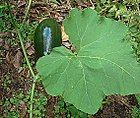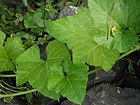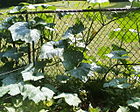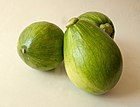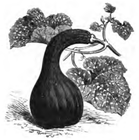Note: This is a project under development. The articles on this wiki are just being initiated and broadly incomplete. You can Help creating new pages.
Cucurbita moschata - Butternut
Butternut, commonly known as Juglans cinerea or white walnut, is a species of walnut native to the eastern United States and southeast Canada.
Contents
- 1 Uses
- 2 Parts Used
- 3 Chemical Composition
- 4 Common names
- 5 Properties
- 6 Habit
- 7 Identification
- 8 List of Ayurvedic medicine in which the herb is used
- 9 Where to get the saplings
- 10 Mode of Propagation
- 11 How to plant/cultivate
- 12 Commonly seen growing in areas
- 13 Photo Gallery
- 14 References
- 15 External Links
Uses
abdominal cramps, intestinal worms, tape worm, reddish blotches, haemorrhages, jaundice, headache, ophthalmia, kinds of tumours
Parts Used
Flowers, Seed, Leaves, young stems, Fruit
Chemical Composition
Protein was analyzed using the macro-Kjeldahl method (AOAC 984.13) using a Foss Kjeltec 2300 automatic analyzer (Foss Tecator AB, Höganäs, Sweden)[1]
Common names
| Language | Common name |
|---|---|
| Kannada | sihi kumbala kaayi |
| Hindi | halwa kaddu |
| Malayalam | kumpalam |
| Tamil | pucani |
| Telugu | gummadi |
| Marathi | NA |
| Gujarathi | NA |
| Punjabi | NA |
| Kashmiri | NA |
| Sanskrit | |
| English | Butternut Pumpkin, butternut squash |
Properties
Reference: Dravya - Substance, Rasa - Taste, Guna - Qualities, Veerya - Potency, Vipaka - Post-digesion effect, Karma - Pharmacological activity, Prabhava - Therepeutics.
Dravya
Rasa
Guna
Veerya
Vipaka
Karma
Prabhava
Habit
Identification
Leaf
| Kind | Shape | Feature |
|---|---|---|
| Simple | Prostrate | Internodes to 10 cm, scabrous. Leaves 5-7-lobed, 16 x 24 cm, velvety, lobes acute; petiole to 15 cm |
Flower
| Type | Size | Color and composition | Stamen | More information |
|---|---|---|---|---|
| Unisexual | 8 cm wide | pale yellow | Stamens 3 | Flowers Season is June - August |
Fruit
| Type | Size | Mass | Appearance | Seeds | More information |
|---|---|---|---|---|---|
| Stamens 3 | 6 cm | Fruit oblong, contracted in the middle | seeds numerous, to 12 x 8 mm | {{{6}}} |
Other features
List of Ayurvedic medicine in which the herb is used
- Vishatinduka Taila as root juice extract
Where to get the saplings
Mode of Propagation
How to plant/cultivate
The plant can be grown from the temperate zone to the tropics, so long as there is a warm growing season of at least 150 days[3]
Commonly seen growing in areas
Tropical Asia, South America, North America.
Photo Gallery
References
External Links
- Pages that are stubs
- Ayurvedic Herbs known to be helpful to treat abdominal cramps
- Ayurvedic Herbs known to be helpful to treat intestinal worms
- Ayurvedic Herbs known to be helpful to treat tape worm
- Ayurvedic Herbs known to be helpful to treat reddish blotches
- Ayurvedic Herbs known to be helpful to treat haemorrhages
- Ayurvedic Herbs known to be helpful to treat jaundice
- Ayurvedic Herbs known to be helpful to treat headache
- Ayurvedic Herbs known to be helpful to treat ophthalmia
- Ayurvedic Herbs known to be helpful to treat kinds of tumours
- Herbs with Flowers used in medicine
- Herbs with Seed used in medicine
- Herbs with Leaves used in medicine
- Herbs with young stems used in medicine
- Herbs with Fruit used in medicine
- Herbs with common name in Kannada
- Herbs with common name in Hindi
- Herbs with common name in Malayalam
- Herbs with common name in Tamil
- Herbs with common name in Telugu
- Herbs with common name in English
- Habit - Annual Climber Tree
- Index of Plants which can be propagated by Seeds
- Herbs that are commonly seen in the region of Tropical Asia
- Herbs that are commonly seen in the region of South America
- Herbs that are commonly seen in the region of North America
- Herbs

